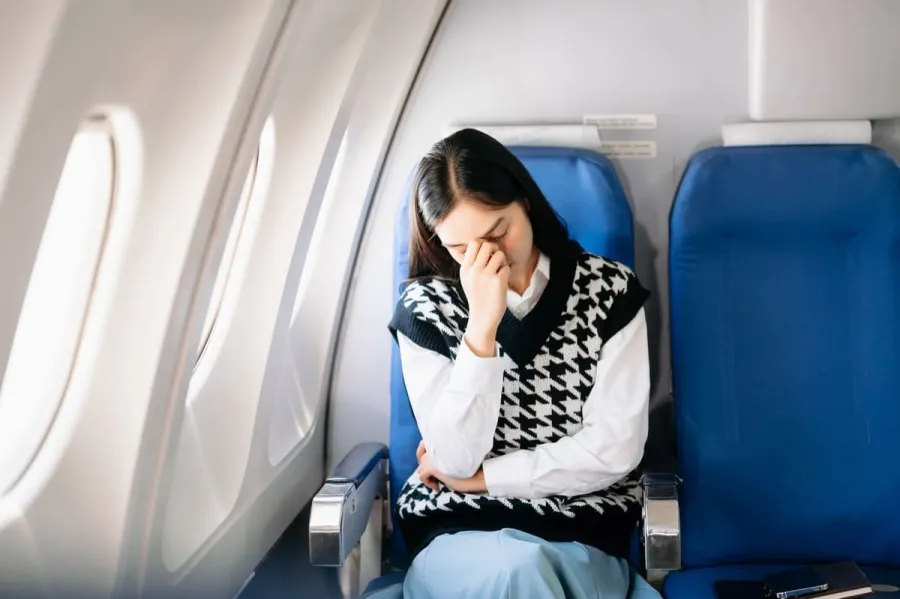Change language
How to prevent ear pressure and headaches while traveling: essential tips
May 23, 2025

We’ve all been there—settling in for a flight, train ride, or long car journey, only to feel that uncomfortable pressure building in our ears or a dull headache creeping in. Whether it’s the sudden altitude changes, cabin pressure, or hours spent in a confined space, travel can take a toll on your body in unexpected ways.
The good news? A few simple strategies can make a world of difference in keeping discomfort at bay.
In this article, we’ll break down why ear pressure and travel headaches happen and, more importantly, how to prevent them. Whether you're a frequent flyer, a road trip enthusiast, or just prepping for your next getaway, these essential tips will help you travel more comfortably and arrive at your destination feeling refreshed.
Why do I get a headache before or after flying?
Headaches before or after flying are quite common and can be caused by several factors related to air travel. Here are the most likely reasons:
1. Changes in Air Pressure (Barotrauma Headaches)
When the airplane ascends or descends, the rapid changes in cabin pressure can affect the air-filled spaces in your body, particularly your sinuses and ears. If your Eustachian tubes (which help equalize pressure in your ears) don’t adjust quickly, it can lead to sinus pressure, causing a headache.
2. Dehydration
Airplane cabins have very low humidity levels, leading to dehydration faster than usual. Even mild dehydration can cause headaches, fatigue, and dizziness.
3. Oxygen Levels and Cabin Air
Cabin air has lower oxygen levels than what you’re used to on the ground. This can cause slight hypoxia (lower oxygen in the blood), leading to headaches, especially in people who are sensitive to altitude changes.
4. Stress and Anxiety
Pre-flight stress, rushing through security, or anxiety about flying can trigger tension headaches. Even if you're not prone to anxiety, the overall travel experience can be exhausting and contribute to headaches. Interestingly, just as smoking on a plane was once a common occurrence (before it was banned for health and safety reasons), many travelers underestimate how much poor air quality and stress can contribute to headaches mid-flight.
5. Lack of Sleep or Jet Lag
If you've had an early morning flight, a long layover, or are traveling across time zones, sleep deprivation and jet lag can lead to headaches.
6. Muscle Tension from Sitting Too Long
Sitting in one position for an extended period, especially in cramped airline seats, can cause neck and shoulder tension, which may lead to headaches.
7. Caffeine Withdrawal or Overconsumption
If you rely on caffeine daily but skip your usual coffee due to an early flight, withdrawal symptoms can kick in, causing a headache. On the flip side, too much caffeine (from airport coffee or energy drinks) can lead to dehydration and headaches.
Motion sickness headaches
Another possible cause of an airplane or travel headache is barometric pressure changes. As the aircraft ascends or descends, rapid shifts in cabin pressure can affect the sinuses and inner ear, leading to discomfort or headaches. Those who are sensitive to weather changes may be more prone to barometric pressure headaches. These headaches can feel similar to sinus headaches, with symptoms including facial pain, ear pressure, and a sense of fullness in the head.
How to prevent a travel headache
1. Try Some Relaxation Techniques
If you’re a nervous flyer and know that stress is one of your headache triggers, try some relaxation techniques while you’re on the plane. While you can’t exactly roll out a yoga mat in the aisle, deep breathing, progressive muscle relaxation, or listening to calming music can help ease tension. If you start feeling overwhelmed, try some light stretching, meditation, or even tai chi movements from your seat.
2. Exercise or Stretch Before Your Flight
Exercise has proven benefits for preventing and alleviating headaches, so squeezing in a light workout or some stretching before your flight can make a big difference. A short walk at the airport, gentle neck and shoulder stretches, or even using a massage ball can help reduce tension and improve circulation. Just remember to avoid overexerting yourself, as overly strenuous exercise can sometimes trigger headaches.
3. Stay Hydrated
Dehydration is one of the most common causes of travel headaches, especially with the dry air inside an airplane cabin. Drink plenty of water before and during your flight, and avoid excessive caffeine or alcohol, as they can contribute to dehydration. Bringing an empty water bottle to refill after security can help ensure you stay hydrated throughout your journey.
4. Avoid Altering Your Diet
If you’re prone to food-related headaches, avoid trying new or risky foods right before or during your flight. Stick to your usual diet and prioritize nutrient-rich foods like fruits, vegetables, and whole grains. Since travel schedules can make it hard to eat at regular times, try to plan your meals in advance or pack headache-friendly snacks.
5. Manage Your Sleep Schedule
Lack of sleep or disruptions to your sleep cycle due to early flights, long layovers, or jet lag can contribute to headaches. Try to get a good night's rest before traveling, use an eye mask and noise-canceling headphones to rest on the plane, and adjust your sleep schedule gradually if you’re traveling across time zones.
6. Pack Your Headache Essentials
If you frequently experience headaches while traveling, prepare by packing essentials in your carry-on. This can include medications, cooling or heating packs, an eye mask, earplugs, or noise-canceling headphones. Items like peppermint oil or a cooling forehead strip can also help relieve tension headaches mid-flight. If you’re bringing medication, make sure you follow the airline's guidelines. You can check out our article on Rules and Recommendations for the Transport of Pills During Air Travel for more details.
7. Adjust Your Posture and Movement
Sitting in the same position for long hours can lead to muscle stiffness and tension headaches. Adjust your posture regularly, support your lower back with a cushion, and take breaks to stand up and move around the cabin when possible. Simple seated stretches for your neck, shoulders, and lower back can help keep tension at bay.
Methods of avoiding and treating ear pain during flights
If you’ve ever felt that uncomfortable pressure or sharp pain in your ears while flying, you’re not alone. Airplane ear is a common issue caused by rapid altitude changes during take-off and landing, making it difficult for your ears to equalize pressure. Fortunately, there are simple ways to prevent and relieve this discomfort. Whether you're a frequent traveler or just preparing for your next flight, these tips will help keep your ears pain-free and your journey more enjoyable.
Stay Awake During Take-Off and Landing
Sleeping on a flight is generally fine, but it’s best to stay awake during take-off and landing when air pressure changes are most extreme. If you’re asleep, you won’t be able to take proactive steps like swallowing or yawning to help equalize pressure in your ears. Setting a reminder or alarm on your phone can help wake you up before landing so you can prepare your ears for the pressure shift. Staying alert during these critical moments can also help those trying to overcome the fear of flying, as it allows them to stay in control and actively manage any discomfort.
Chew Gum or Suck on Candy
Chewing gum, sucking on hard candy, or even taking small sips of water can help stimulate swallowing, which keeps the Eustachian tubes open. These tubes connect the middle ear to the back of the throat and help regulate air pressure. Yawning also has a similar effect, so if you feel pressure building, try forcing a few yawns to relieve discomfort.
Use a Nasal Decongestant
If you’re prone to congestion or have a mild cold, using a decongestant spray or taking an over-the-counter (OTC) decongestant 30 minutes before your flight can help prevent ear pain. These medications work by reducing swelling in the nasal passages and Eustachian tubes, making it easier for air pressure to equalize. Be sure to follow dosage instructions and consult a doctor if you have any underlying conditions before using decongestants.
Try Special Earplugs
Filtered earplugs designed for flying can help slow down the rate of pressure change in the ears, reducing discomfort. These earplugs regulate the air pressure entering the ear canal, making it easier for your ears to adjust during altitude changes. They are especially useful for people who frequently experience ear pain while flying.
Practice the Valsalva Maneuver
This technique helps regulate middle ear pressure and can be particularly effective during take-off and landing. To do the Valsalva maneuver:
- Pinch your nostrils shut.
- Keep your mouth closed.
- Gently blow air as if you’re trying to exhale through your nose.
- Repeat as needed until you feel your ears pop and the pressure equalizes.
- Be careful not to blow too hard, as this can cause additional discomfort.
Keep Your Nasal Passages Moist
Dry cabin air can worsen congestion and make it harder for the Eustachian tubes to function properly. Using a saline nasal spray before and during your flight can help keep your nasal passages hydrated and reduce the risk of ear pain.
Avoid Flying with a Cold or Sinus Infection
If you have a cold, sinus infection, or ear infection, your risk of experiencing severe ear pain during a flight increases. If possible, consider postponing your flight until you feel better. If rescheduling isn’t an option, staying hydrated, using decongestants, and practicing pressure-relief techniques can help reduce discomfort.
How to treat ear pain in babies, toddlers, and infants
Young children are more prone to ear pain during flights due to their smaller and more horizontal Eustachian tubes, which make it harder to equalize pressure. They also have a higher chance of experiencing congestion from colds or respiratory infections, which can worsen ear discomfort.
To help ease ear pain in babies and toddlers during flights, parents and caregivers can:
- Avoid flying when the child is sick or ensure they stay well-hydrated before and during the flight.
- Encourage swallowing by offering a bottle, breastfeeding, or using a pacifier for infants during take-off and landing.
- Give older children juice or water to sip on, or provide gum (if age-appropriate) to encourage chewing.
- Gently wake a sleeping baby during take-off and landing to prevent pressure buildup.
- Use a nasal bulb syringe or saline drops to help clear congestion before the flight.
- Follow a doctor’s advice for treating cold symptoms if the child is already congested.
- Taking these simple steps can help minimize discomfort and make flying easier for both the child and caregiver.
Next time you fly, put these tips into practice and see what works best for you. If you frequently struggle with ear pain or headaches, consider keeping a travel kit with essentials like earplugs, gum, nasal sprays, and hydration aids. Safe and pain-free travels start with a little preparation—so why not try these methods on your next flight?
More travel blog recommendations

Gør dit forsinkede, aflyste eller overbookede fly til en kompensation på op til €600!
Kompensation for flyforsinkelse annulleret
Flyrefusion for et aflyst forsinket fly
Flykompensation
©2025 AirClaim.com - Alle rettigheder forbeholdt Air Claim SA - Bdul. Pipera 1/Vi Bl. HYPERION TOWERS Et. 3 SP. BIR. 3 Cod 077190, Voluntari, Ilfov, Rumænien

















